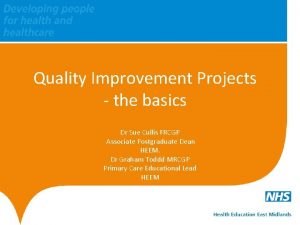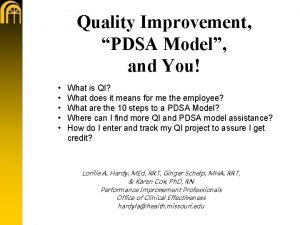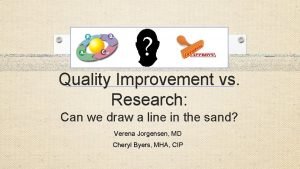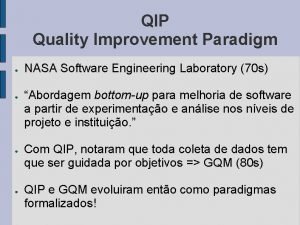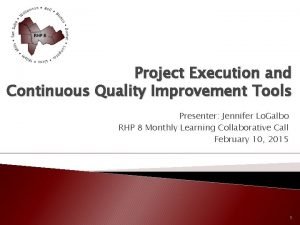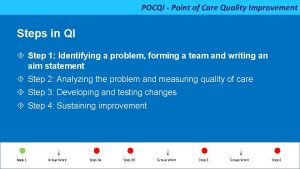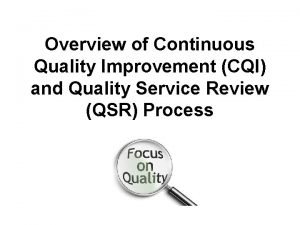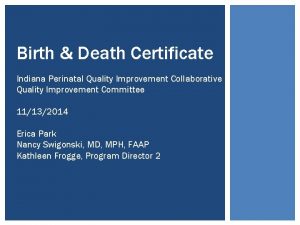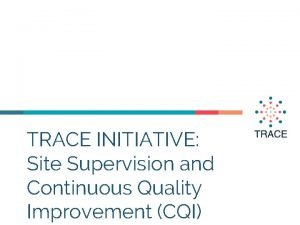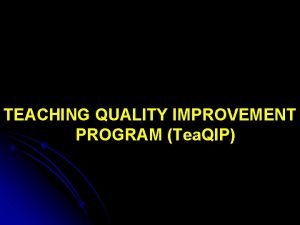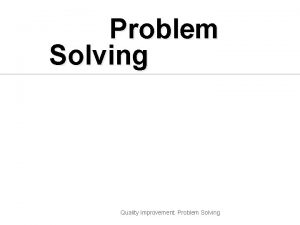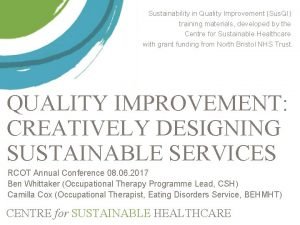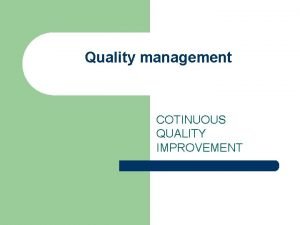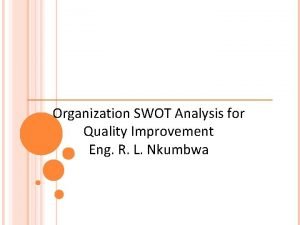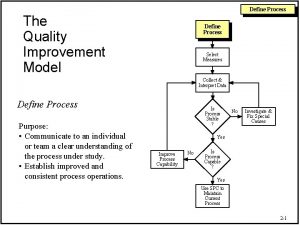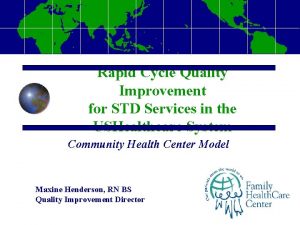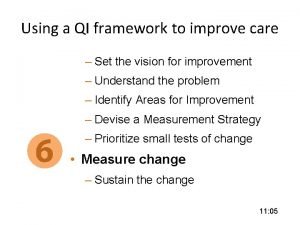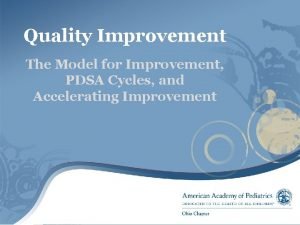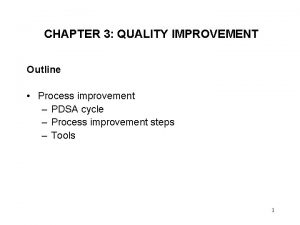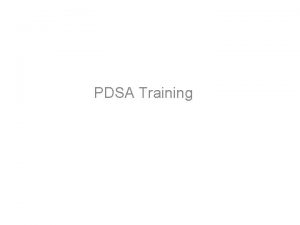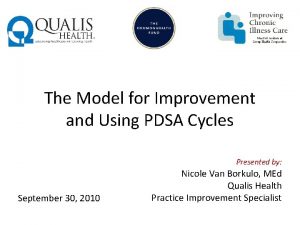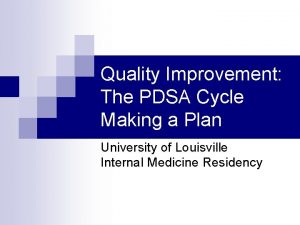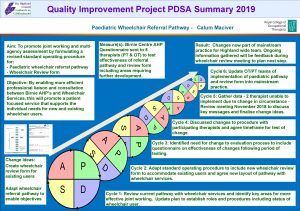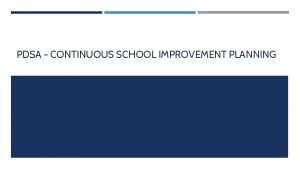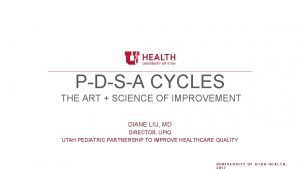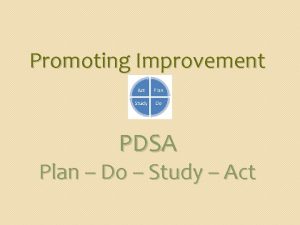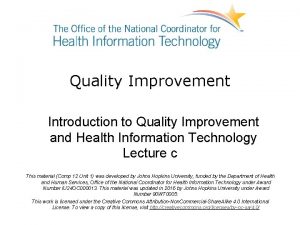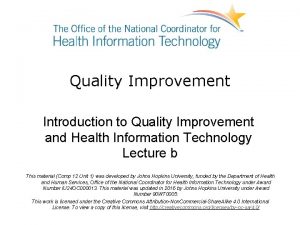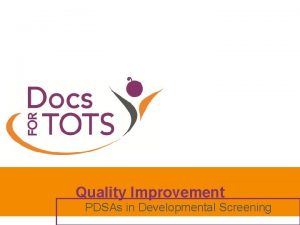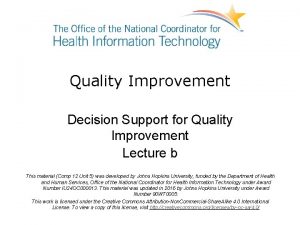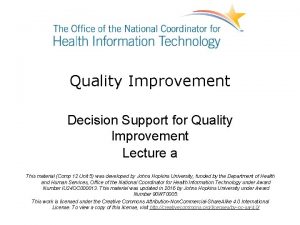Quality Improvement PDSA Model and You What is


























- Slides: 26

Quality Improvement, “PDSA Model”, and You! • • • What is QI? What does it means for me the employee? What are the 10 steps to a PDSA Model? Where can I find more QI and PDSA model assistance? How do I enter and track my QI project to assure I get credit? Lorilie A. Hardy, MEd, RRT, Ginger Schelp, MHA. RRT, & Karen Cox, Ph. D, RN Performance Improvement Professionals Office of Clinical Effectiveness hardyla@health. missouri. edu

What is Quality Improvement? “The combined and unceasing efforts of everyone: – – – Patients and their families Healthcare Professionals Healthcare Researchers Healthcare Payers Healthcare Planners/Coordinators Healthcare Educators to make the changes that will lead to: • better patient outcomes (health) • better system performance (care), and • better professional development (learning). ” http: //qualitysafety. bmj. com/content/16/1/2. extract

What this means for you… 1. MU Health Care employees (≥ 50% FTE) are required to participate and complete a minimum of 2 QI (aka PDSA) projects (2 projects / 2 aim statements) per year either individual or group. (<50% FTE employees are highly encouraged to participate in QI projects) 2015 QI (PDSA) Requirements for credit: • Two competed QI projects: – 2 aim statements= two projects – PDSA EDUCATION NO longer counts as a project • “Project Categories and Metrics” completed for each • Both projects completed and in QI Tracker by June 30, 2015 2. Use the “PDSA” model for each quality improvement project. 3. Use the MUHC QI Tracker to track your 2 QI Projects (aka PDSAs). • MUHC QI Tracker is open from Aug 15 - June 30 annually.

What QI projects should you participate in? Create a new QI regarding a proven problem: - OR - S g t n re i t am s e r lin e t EXCITING e In y c n e i c i f f E Passiona te Choose an existing QI team/committee: – Hospital-wide • • Fall Prevention CAUTI VAE Patient Satisfaction – Unit specific: • Staff Morale • Cerner Documentation • Through-put s s e n e v i t Effec Your participation is vital, as YOU know BEST how to improve the care you give your patients!

The “PDSA” Model for Quality Improvement “Plan-Do-Study-Act” 1. What proven problem do we have to improve? Pre-data 2. What change can we implement that will result in improvement? Aim Statement 3. How will we know that a change is an improvement? Post-data (Metric = the measurement of data to compare before and after the change)

10 Steps to PDSA Model PLAN-DO-STUDY-ACT PLAN: WHAT ARE WE TRYING TO ACCOMPLISH? 1. Choose a problem that aligns with UH strategic goals: People, Growth, Financial, Quality, Patient Experience, Work Environment, Information Technology 2. Identify a leader (you or a peer) and executive sponsor (SLS, Manager, or PIP) 3. Assemble the improvement team (just yourself or you, other co-workers and resources) 4. Study baseline (current state) pre-data – MUST have proof this needs improvement! 5. Outline how the “current state” process works 6. Find out how others have tried to solve this or a similar challenge: research literature for evidence based best practices, brainstorm, etc. 7. Determine potential solutions: prioritize solutions and use one solution per cycle

PLAN-DO-STUDY-ACT (10 -step model) 8. “DO”: Implement or Trial the “CHANGE/SOLUTION” that may RESULT in IMPROVEMENT for the designated timeframe. 9. STUDY: HOW is it KNOWN that the CHANGE is an IMPROVEMENT? *Measure the impact of the solution with objective data Use graphs or charts * 10. ACT: IMPLEMENT or REVISE AND REPEAT THE PLANDO-STUDY-ACT CYCLE(S) UNTIL the GOAL is ACHIEVED: *Try different solutions one at a time until the goal is achieved *Each solution is a new cycle


Where can I find QI / PDSA model assistance? & How do I enter and track my QI project to assure I get credit?

Helpful PDSA Tools can be located in “My Apps”→”QI Resources→”QI/PI” 2 3 1

Where to enter your PDSA project information


QI Tracker Basics 1 b- educational informative 4 minute video. 2 b Add new project 8 questions: (Title, Aim Statement, Type [MUHC, SOM, etc), Aim of Project [Met/In Progress/ Not Met], Status [active/Complete/Discontinued], Second Editor, Start and End dates) free text and drop down menus and submit 3 b. Add persons INCULDING YOURSELF and assure you have a manager, SLS, or PIP as your “SPONSOR”, a staff members will be the “team lead or team member”, any UH employee can be a Facilitator/Coach/Advisor 4 b. Three drop down menus: major category [select the UH strategic goal that aligns with your project], subcategory [select most appropriate] , and Metric [select most appropriate or “other” and free text your metric]). Repeat to add multiple categories as indicated by the project.

“PDSA” Template (located on QI Tracker)

“How to” Template for a Final “Single Cycle” of a Project

Plan-Do-Study-Act Cycles • Repeated measurement and subsequent adjustment in “cycles or interventions” until the goal is met. Hunches Theories Ideas P D S A 1. Revise Policy P D S A 2. Educate Staff P D S A 3. change printers P D S A Changes that result in improvement 4. positive Pt ID prior to blood draw

Sample “How To” Template for a Final “Multi-Cycle” Project

Resources for Planning a QI Project Brainstorming Cause Mapping Direct Observation Time Motion Studies Check Sheets Affinity Diagram Medical Journals Evidence Based Standard Practices……… Practices

SAMPLE PDSA Planning:

Use Graphs and Charts

“PDSA” is a Model for Improvement Aim Statement = Details of the change to be made to result in improvement Metrics: The measurement that will prove the change is an improvement ACT PLAN STUDY DO

“Aim Statement” requirements: ü Focus on: ü Safe ü Timely ü Effective ü Efficient ü Equitable ü Patient Centered ü Include a specific patient population ü Include numerical goals ü Include a timeframe ü State the aim Clearly: Specific and Concise ü Keep it simple to not expand- stay focused

Examples: Aim Statement, Metric, and Plan • By January 1, 2015, 100% of admitted ED patients will be transferred out of the ED to an in-patient bed within 1 hour of decision to admit. – by comparing Cerner time stamps of ED physician admission orders (decision to admit) and time of nursing floor or ICU admission documentation 3 months prior to and after the initiation of ASCOM phones – Use of ASCOM phones for timely communication to determine and correct throughput issues • Reduce the number of ED patient falls by 75% by January 1, 2015 – Number of falls reported in PSN 3 months prior to and 3 months post the initiation of verbal/brochure education. – the use of verbally communicating to the patient and handing the patient an educational brochure discussing fall prevention while in the hospital (see exhibit a). • Improve ED patient satisfaction with healthcare communication, education, and reconciliation of home medications upon discharge by 75% in 3 months beginning October 1, 2014 – NRC Key Driver scores regarding pt satisfaction with medication education 3 months prior and 3 months after the initiation of nurse and provider education – Educate Nurses and physicians on having the patient repeat his/her understanding of medications.

Helpful Hints using the PDSA Model Take time to: – PLAN the details – Write a sound AIM STATEMENT – Use Quantitative or Qualitative Numeric Metrics – Keep each “cycle” simple to prove success or not, repeat as needed until successful, give recommendations regarding the result of each cycle – Include graphics or charts to show results

Next Service Line Newsletter/E-mail will have a link to: “Quality Improvement, PDSA Model, and You!” Powerpoint on a Service Line Website for future reference.

Got Questions? ? “Without change there is no innovation, creativity, or incentive for improvement. Those who initiate change will have a better opportunity to manage the change that is inevitable. ” Lorilie Hardy -William Pollard ED & Surgical Services Performance Improvement Professional hardyla@health. missouri. edu 884 -1755
 Process of nursing audit
Process of nursing audit Compliance vs quality
Compliance vs quality Pdsa model nhs
Pdsa model nhs Pdsa model nhs
Pdsa model nhs Pdsa template
Pdsa template Jhm irb
Jhm irb Qsen quality improvement examples
Qsen quality improvement examples Quality improvement paradigm
Quality improvement paradigm Continuous quality improvement plan example
Continuous quality improvement plan example Point of care quality improvement
Point of care quality improvement Define continuous quality improvement
Define continuous quality improvement Efmd quality improvement system
Efmd quality improvement system Indiana perinatal quality improvement collaborative
Indiana perinatal quality improvement collaborative Continuous quality improvement program planning worksheet
Continuous quality improvement program planning worksheet Tea quality improvement
Tea quality improvement Quality improvement
Quality improvement Sus qi
Sus qi Quality improvement nurse
Quality improvement nurse Quality improvement
Quality improvement Juran 10 steps to quality improvement
Juran 10 steps to quality improvement Swot analysis quality improvement
Swot analysis quality improvement Mqii
Mqii Quality improvement
Quality improvement Data driven quality
Data driven quality Rapid cycle quality improvement
Rapid cycle quality improvement Crosby quality is free
Crosby quality is free Pdsa worksheet
Pdsa worksheet


